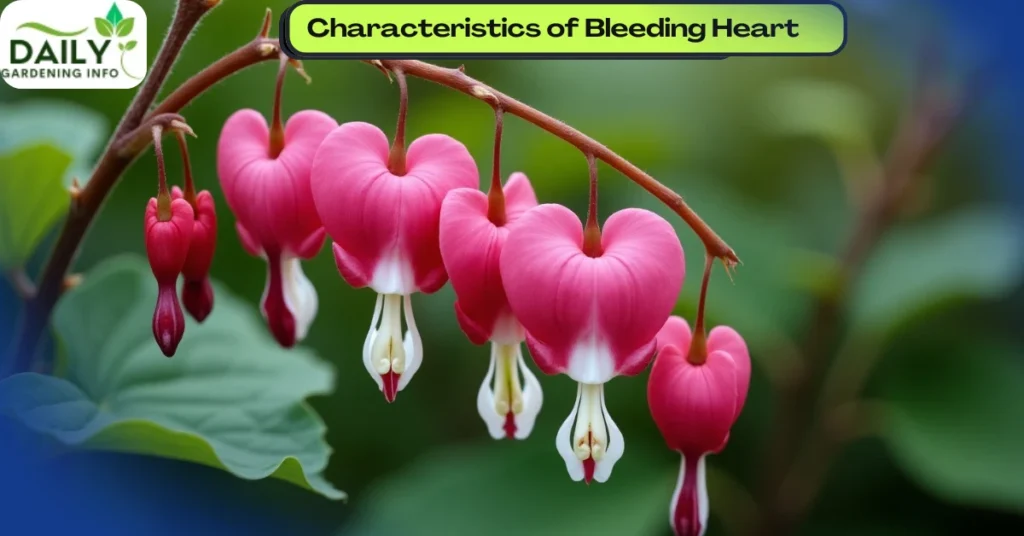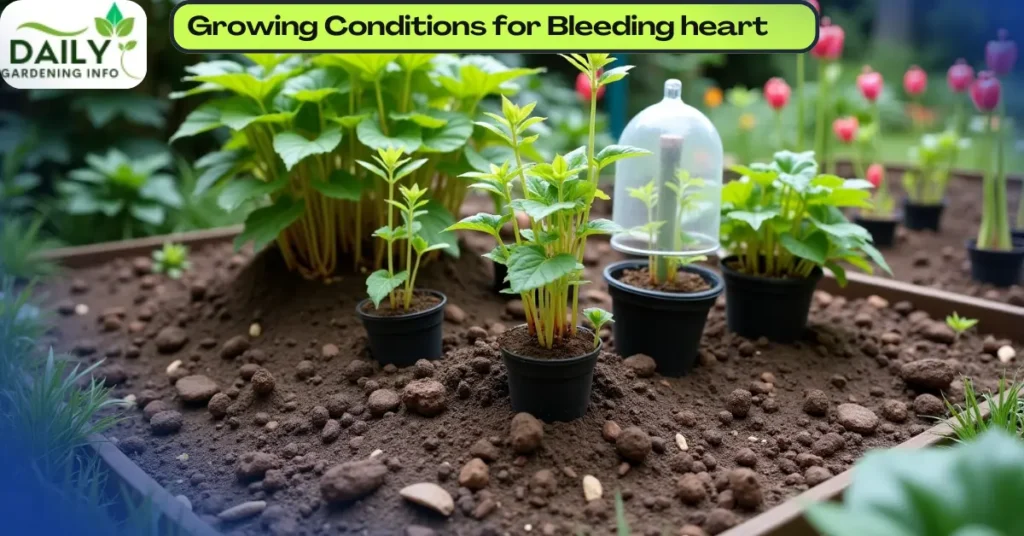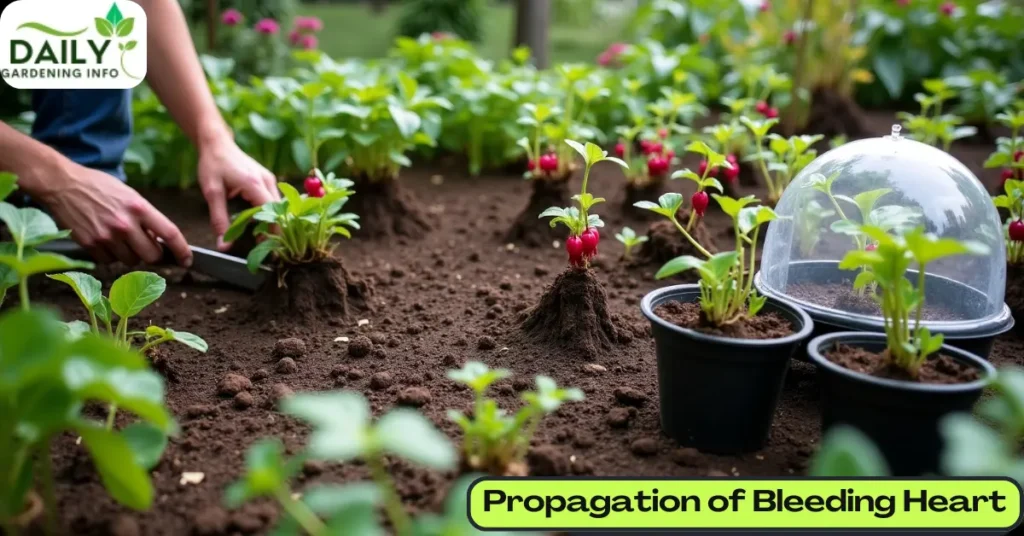The Bleeding Heart Plant, scientifically known as Lamprocapnos spectabilis, is a cherished perennial flowering plant from the poppy family, Papaveraceae. Native to Siberia, Northern China, Korea, and Japan, this stunning plant boasts captivating crimson and white blooms that appeal to both novice and experienced gardeners.
In this comprehensive guide, you’ll discover the Bleeding Heart’s unique characteristics, ideal growing conditions, propagation techniques, container gardening tips, sustainable blooming practices, solutions to common problems, and creative design ideas to cultivate this elegant plant in your garden.
Characteristics of Bleeding Heart
The Bleeding Heart (Lamprocapnos spectabilis) is renowned for its heart-shaped flowers that dangle like droplets, resembling a “bleeding” effect. These blossoms typically feature vibrant pink or red outer petals with delicate white inner petals, reminiscent of hummingbird mint plants.
This herbaceous perennial grows to a height of 2 to 3 feet and spreads 18 to 24 inches wide. Its fern-like, light-green foliage adds a soft texture to gardens. The Bleeding Heart naturally dies back in late fall to early winter (November to December in temperate climates) and reemerges in spring, typically between March and April, making it a seasonal favorite.

Ideal Growing Conditions for Bleeding Heart
To thrive, the Bleeding Heart requires conditions mirroring its native woodland habitats.
Light Requirements
This plant excels in shaded or partially shaded areas, making it an excellent choice for woodland gardens or shaded yard corners with filtered sunlight. While it tolerates full sun, excessive exposure can scorch its leaves and diminish blooming. For optimal growth, provide 2-4 hours of filtered sunlight daily in a partial shade setting.
Soil Preferences
The bleeding heart prefers acidic to neutral, well-drained soil that retains moisture without becoming waterlogged. Enriching the soil with organic matter, such as compost or farmyard manure, boosts fertility. Aim for a soil pH between 6.0 and 7.0 to ensure a healthy, thriving plant.
Temperature and Humidity
Adaptable to USDA zones 3 to 9, the Bleeding Heart suits diverse climates, from Texas to southern California. It flourishes in cool temperatures between 60°F and 75°F (15°C to 24°C). Maintain soil moisture at 50-60% by watering when the top 1-2 inches of soil feel dry, especially during warmer months like May to August.

Tips for Propagating Bleeding Heart
Propagating the Bleeding Heart is straightforward using division or cuttings, allowing you to multiply its beauty across your garden or share with others.
A: Propagation Through Division
When to Do It: Spring (April to May) or fall (September to October) offers cooler temperatures that minimize plant stress and promote rooting.
How to Do It:
- Gently dig up clumps of the Bleeding Heart, taking care not to harm the roots.
- Using a sanitized sharp knife or spade, divide the roots into sections, ensuring each has roots and at least one healthy shoot.
- Replant divisions 18 to 24 inches apart in prepared soil to allow air circulation and nutrient access.
- Water thoroughly to settle the soil around the roots.

B: Propagation Through Cuttings
When to Take Cuttings: Early summer (around June) is ideal. Select healthy Bleeding Heart stems and cut 4- to 6-inch sections just below a leaf node, where rooting hormones are concentrated.
How to Do It:
- Remove lower leaves with a pruner to expose nodes and prevent rot.
- Plant cuttings in a 4- to 6-inch pot filled with a well-draining mix (e.g., potting soil with perlite or sand).
- Water generously and maintain consistent moisture, using a plastic bag or humidity dome to retain humidity.
- Position the pot in indirect light; roots should form within 4 to 6 weeks.
Additional Tips
- Soil Requirements: Use well-draining, organic-rich soil. Add 1-2 inches of compost for enhanced fertility.
- Care After Propagation: Monitor water needs and watch for pests like aphids or mealybugs, treating with insecticidal soap or neem oil if necessary.
Step-by-Step Guide: Growing Bleeding Heart in a Container
Growing bleeding heart in containers is perfect for small spaces like patios or balconies, offering flexibility and charm.
- Choose a Pot: Select a container at least 12 inches wide with drainage holes.
- Prepare the Soil: Use a well-draining potting mix enriched with compost.
- Planting: Position the Bleeding Heart so its crown sits at soil level.
- Fill the Pot: Add soil around the roots, leaving space at the top for watering.
- Water: Water thoroughly after planting, keeping soil evenly moist but not soggy.
- Placement: Place the pot in a shady or partially shaded spot.
- Care: Water regularly, ensure proper drainage, and apply mulch (e.g., shredded bark or straw) to retain moisture.
Keeping Bleeding Heart Blooming
Regular Care Tips
To sustain vibrant Bleeding Heart blooms, remove faded flowers to encourage new growth, though deadheading isn’t essential. Apply a balanced, slow-release fertilizer (10-10-10 N-P-K) in early spring to support development.
Seasonal Attention Tips
- Spring: Monitor new growth from March to April after the last frost.
- Summer: Protect from heat during June to August with afternoon shade and consistent watering.
Common Problems & Solutions for Bleeding Heart
Pest Infestations
The Bleeding Heart may attract slugs, aphids, and spider mites. Slugs chew leaves, aphids sap plant vitality, and spider mites cause yellowing with fine webs.
- Solution: Apply insecticidal soap (2 tablespoons per gallon of water) or neem oil (1-2 tablespoons per gallon) to affected areas. Spray in the early morning or evening, repeating every 7-14 days as needed.
Disease Infections
Powdery mildew, a fungal issue, appears as a white coating on leaves from May to July.
- Solution: Improve air circulation, avoid overhead watering, and use fungicides like sulfur or neem oil if necessary.
Design Ideas for Bleeding Heart
- Border Planting: Line pathways or fill gaps with Bleeding Heart for a graceful, flowing effect.
- Container Gardening: Grow in pots for patios or balconies, ensuring ample space and drainage.
- Companion Planting: Pair with hummingbird mint to attract pollinators and enhance garden biodiversity.
Conclusion
The Bleeding Heart is a breathtaking addition to any garden, blending delicate beauty with resilience. With proper care—shaded conditions, well-drained soil, and regular maintenance—this plant thrives for years, adding warmth and elegance to spring landscapes. Whether in borders, containers, or paired with other plants, the bleeding heart elevates shaded spaces with timeless charm.

Leave a Reply